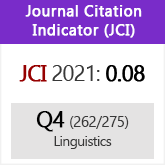Is there an interlanguage intelligibility benefit in perception of English word stress?
DOI:
https://doi.org/10.3989/loquens.2019.061Keywords:
interlanguage intelligibility benefit, word-stress, perception, L2 English, L1 ArabicAbstract
This paper asks whether there is an ‘interlanguage intelligibility benefit’ in perception of word-stress, as has been reported for global sentence recognition. L1 English listeners, and L2 English listeners who are L1 speakers of Arabic dialects from Jordan and Egypt, performed a binary forced-choice identification task on English near-minimal pairs (such as[ˈɒbdʒɛkt] ~ [əbˈdʒɛkt]) produced by an L1 English speaker, and two L2 English speakers from Jordan and Egypt respectively. The results show an overall advantage for L1 English listeners, which replicates the findings of an earlier study for general sentence recognition, and which is also consistent with earlier findings that L1 listeners rely more on structural knowledge than on acoustic cues in stress perception. Non-target-like L2 productions of words with final stress (which are primarily cued in L1 production by vowel reduction in the initial unstressed syllable) were less accurately recognized by L1 English listeners than by L2 listeners, but there was no evidence of a generalized advantage for L2 listeners in response to other L2 stimuli.
Downloads
References
Almbark, R., Bouchhioua, N., & Hellmuth, S. (2014). Acquiring the phonetics and phonology of English word stress: Comparing learners from different L1 backgrounds. Proceedings of the International Symposium on the Acquisition of Second Language Speech, Concordia Working Papers in Applied Linguistics, 5.
Bates, D., Maechler, M., Bolker, B., & Walker, S. (2015). Fitting linear mixed-effects models using lme4. Journal of Statistical Software, 67(1), 1-48. https://doi.org/10.18637/jss.v067.i01
Beckman, M., & Edwards, J. (1994). Articulatory evidence for differentiating stress categories. In P. Keating (Ed.), Phonological structure and phonetic form: Papers in Laboratory Phonology III (pp. 7-33). Cambridge: Cambridge University Press. https://doi.org/10.1017/CBO9780511659461.002
Bent, T., & Bradlow, A. R. (2003). The interlanguage speech intelligibility benefit. The Journal of the Acoustical Society of America, 114(3), 1600-1610. https://doi.org/10.1121/1.1603234 PMid:14514213
Bouchhioua, N. (2008). The acoustic correlates of stress and accent in Tunisian Arabic: A comparative study with English [Unpublished PhD dissertation]. University of Carthage, Tunisia.
Bouchhioua, N. (2016). Typological variation in the phonetic realization of lexical and phrasal stress: Southern British English vs. Tunisian Arabic. Loquens, 3(2), e034. https://doi.org/10.3989/loquens.2016.034
Chahal, D., & Hellmuth, S. (2015). Comparing the intonational phonology of Lebanese and Egyptian Arabic. In S.-A. Jun (Ed.), Prosodic typology. Volume 2 (pp. 365-404). Oxford: Oxford University Press. https://doi.org/10.1093/acprof:oso/9780199567300.003.0013
Chrabaszcz, A., Winn, M., Lin, C. Y., & Idsardi, W. J. (2014). Acoustic cues to perception of word stress by English, Mandarin, and Russian speakers. Journal of Speech, Language, and Hearing Research, 57(4), 1468-1479. https://doi.org/10.1044/2014_JSLHR-L-13-0279 PMid:24686836 PMCid:PMC5503100
Cole, J., Mo, Y., & Hasegawa-Johnson, M. (2010). Signal-based and expectation-based factors in the perception of prosodic prominence. Laboratory Phonology, 1(2), 425-452. https://doi.org/10.1515/labphon.2010.022
Core Team, R. (2014). R: A language and environment for statistical computing. Vienna: Austria. Retrieved from http://www.R-project.org/
Cruttenden, A. (2006). The de-accenting of old information: A cognitive universal. In G. Bernini & M. L. Schwartz (Eds.), Pragmatic organization of discourse in the languages of Europe (pp. 311-355). Berlin: Mouton de Gruyter.
Cutler, A. (1986). Forebear is a homophone: Lexical prosody does not constrain lexical access. Language and Speech, 29(3), 201-220. https://doi.org/10.1177/002383098602900302
de Jong, K., & Zawaydeh, B. A. (1999). Stress, duration, and intonation in Arabic word-level prosody. Journal of Phonetics, 27(1), 3-22. https://doi.org/10.1006/jpho.1998.0088
Dupoux, E., Pallier, C., Sebastián-Gallés, N., & Mehler, J. (1997). A destressing 'deafness' in French? Journal of Memory and Language, 36, 406-421. https://doi.org/10.1006/jmla.1996.2500
Dupoux, E., Sebastián-Gallés, N., Navarrete, E., & Peperkamp, S. (2008). Persistent stress "deafness": The case of French learners of Spanish. Cognition: International Journal of Cognitive Science, 106, 682-706. https://doi.org/10.1016/j.cognition.2007.04.001 PMid:17592731
Eriksson, A., Thunberg, G. C., & Traunmüller, H. (2001). Syllable prominence: A matter of vocal effort, phonetic distinctness and top-down processing. EUROSPEECH-2001, 399-402.
Fry, D. (1955). Duration and intensity as physical correlates of linguistic stress. Journal of the Acoustical Society of America, 27(4), 765-768. https://doi.org/10.1121/1.1908022
Gordon, M., & Roettger, T. (2017). Acoustic correlates of word stress: A cross-linguistic survey. Linguistics Vanguard, 3(1). https://doi.org/10.1515/lingvan-2017-0007
Hellmuth, S. (2007). The relationship between prosodic structure and pitch accent distribution: Evidence from Egyptian Arabic. The Linguistic Review, 24(2-3), 289-314. https://doi.org/10.1515/TLR.2007.011
Jun, S.-A. (2014). Prosodic typology: By prominence type, word prosody, and macro-rhythm. In S.-A. Jun (Ed.), Prosodic typology Volume II. (pp. 520-539). Oxford: Oxford University Press. https://doi.org/10.1093/acprof:oso/9780199567300.001.0001
Ladd, D. R. (2008). Intonational phonology (2nd ed.). Cambridge: Cambridge University Press. https://doi.org/10.1017/CBO9780511808814
Lenth, R. V. (2016). Least-squares means: The R package lsmeans. Journal of Statistical Software, 69(1), 1-33. https://doi.org/10.18637/jss.v069.i01
Mattys, S., White, L., & Melhorn, J. (2005). Integration of multiple segentation cues: A hierarchical framework. Journal of Experimental Psychology: General, 134, 477-500. https://doi.org/10.1037/0096-3445.134.4.477 PMid:16316287
Ohala, J. (1993). The phonetics of sound change. In C. Jones (Ed.), Historical linguistics: Problems and perspectives (pp. 237-278). London: Longman.
Qin, Z., Chien, Y.-F., & Tremblay, A. (2017). Processing of word-level stress by Mandarin-speaking second language learners of English. Applied Psycholinguistics, 38(3), 541-570. https://doi.org/10.1017/S0142716416000321
Roettger, T., & Gordon, M. (2017). Methodological issues in the study of word stress correlates. Linguistics Vanguard, 3(1). https://doi.org/10.1515/lingvan-2017-0006
Selinker, L. (1972). Interlanguage. IRAL-International Review of Applied Linguistics in Language Teaching, 10(1-4), 209-232. https://doi.org/10.1515/iral.1972.10.1-4.209
Stibbard, R. M., & Lee, J.-I. (2006). Evidence against the mismatched interlanguage speech intelligibility benefit hypothesis. The Journal of the Acoustical Society of America, 120(1), 433-442. https://doi.org/10.1121/1.2203595 PMid:16875239
SurveyGizmo. (2019). SurveyGizmo | Enterprise Online Survey Software & Tools. Retrieved from https://www.surveygizmo.com/
van Heuven, V., & Sluijter, A. (1996). Notes on the phonetics of word prosody. In R. Goedmans, H. van der Hulst, & E. Visch (Eds.), Stress patterns of the world. Part 1: Background. (pp. 233-269). The Hague: Holland Academic Graphics.
Wagner, P. (2005). Great expectations-introspective vs. perceptual prominence ratings and their acoustic correlates. INTERSPEECH-2005, pp. 2381-2384.
Watson, J. C. E. (2011). Word stress in Arabic. In M. Oostendorp, C. Ewen, E. Hume, & K. Rice (Eds.), The Blackwell Companion to Phonology. Volume 5 (pp. 2990-3018). Oxford: Blackwell. https://doi.org/10.1002/9781444335262.wbctp0124
Wickham, H. (2009). ggplot2: Elegant graphics for data analysis. Springer Science & Business Media. https://doi.org/10.1007/978-0-387-98141-3
Published
How to Cite
Issue
Section
License
Copyright (c) 2019 Consejo Superior de Investigaciones Científicas (CSIC)

This work is licensed under a Creative Commons Attribution 4.0 International License.
© CSIC. Manuscripts published in both the printed and online versions of this Journal are the property of Consejo Superior de Investigaciones Científicas, and quoting this source is a requirement for any partial or full reproduction.All contents of this electronic edition, except where otherwise noted, are distributed under a “Creative Commons Attribution 4.0 International” (CC BY 4.0) License. You may read here the basic information and the legal text of the license. The indication of the CC BY 4.0 License must be expressly stated in this way when necessary.
Self-archiving in repositories, personal webpages or similar, of any version other than the published by the Editor, is not allowed.















